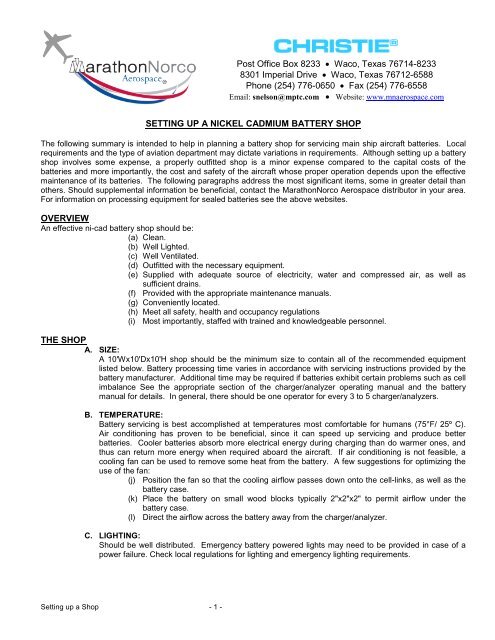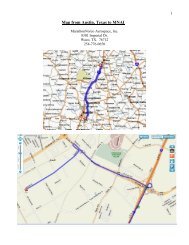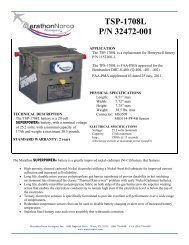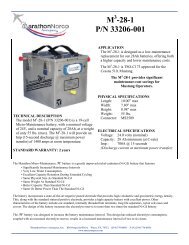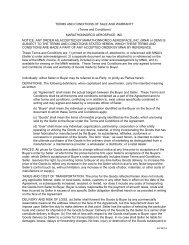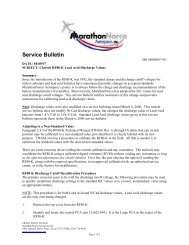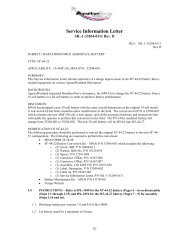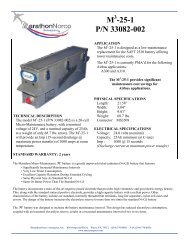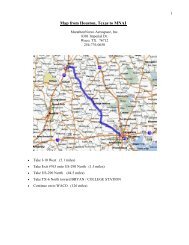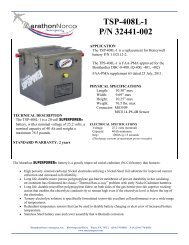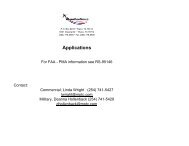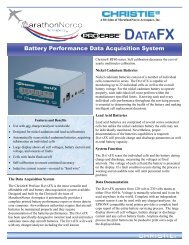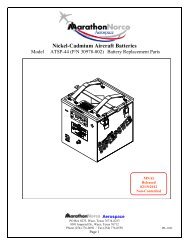Setting Up A Shop - MarathonNorco Aerospace
Setting Up A Shop - MarathonNorco Aerospace
Setting Up A Shop - MarathonNorco Aerospace
Create successful ePaper yourself
Turn your PDF publications into a flip-book with our unique Google optimized e-Paper software.
Post Office Box 8233 • Waco, Texas 76714-8233<br />
8301 Imperial Drive • Waco, Texas 76712-6588<br />
Phone (254) 776-0650 • Fax (254) 776-6558<br />
Email: snelson@mptc.com • Website: www.mnaerospace.com<br />
SETTING UP A NICKEL CADMIUM BATTERY SHOP<br />
The following summary is intended to help in planning a battery shop for servicing main ship aircraft batteries. Local<br />
requirements and the type of aviation department may dictate variations in requirements. Although setting up a battery<br />
shop involves some expense, a properly outfitted shop is a minor expense compared to the capital costs of the<br />
batteries and more importantly, the cost and safety of the aircraft whose proper operation depends upon the effective<br />
maintenance of its batteries. The following paragraphs address the most significant items, some in greater detail than<br />
others. Should supplemental information be beneficial, contact the <strong>MarathonNorco</strong> <strong>Aerospace</strong> distributor in your area.<br />
For information on processing equipment for sealed batteries see the above websites.<br />
OVERVIEW<br />
An effective ni-cad battery shop should be:<br />
(a) Clean.<br />
(b) Well Lighted.<br />
(c) Well Ventilated.<br />
(d) Outfitted with the necessary equipment.<br />
(e) Supplied with adequate source of electricity, water and compressed air, as well as<br />
sufficient drains.<br />
(f) Provided with the appropriate maintenance manuals.<br />
(g) Conveniently located.<br />
(h) Meet all safety, health and occupancy regulations<br />
(i) Most importantly, staffed with trained and knowledgeable personnel.<br />
THE SHOP<br />
A. SIZE:<br />
A 10'Wx10'Dx10'H shop should be the minimum size to contain all of the recommended equipment<br />
listed below. Battery processing time varies in accordance with servicing instructions provided by the<br />
battery manufacturer. Additional time may be required if batteries exhibit certain problems such as cell<br />
imbalance See the appropriate section of the charger/analyzer operating manual and the battery<br />
manual for details. In general, there should be one operator for every 3 to 5 charger/analyzers.<br />
B. TEMPERATURE:<br />
Battery servicing is best accomplished at temperatures most comfortable for humans (75°F/ 25º C).<br />
Air conditioning has proven to be beneficial, since it can speed up servicing and produce better<br />
batteries. Cooler batteries absorb more electrical energy during charging than do warmer ones, and<br />
thus can return more energy when required aboard the aircraft. If air conditioning is not feasible, a<br />
cooling fan can be used to remove some heat from the battery. A few suggestions for optimizing the<br />
use of the fan:<br />
(j) Position the fan so that the cooling airflow passes down onto the cell-links, as well as the<br />
battery case.<br />
(k) Place the battery on small wood blocks typically 2"x2"x2" to permit airflow under the<br />
battery case.<br />
(l) Direct the airflow across the battery away from the charger/analyzer.<br />
C. LIGHTING:<br />
Should be well distributed. Emergency battery powered lights may need to be provided in case of a<br />
power failure. Check local regulations for lighting and emergency lighting requirements.<br />
<strong>Setting</strong> up a <strong>Shop</strong> - 1 -
Post Office Box 8233 • Waco, Texas 76714-8233<br />
8301 Imperial Drive • Waco, Texas 76712-6588<br />
Phone (254) 776-0650 • Fax (254) 776-6558<br />
Email: snelson@mptc.com • Website: www.mnaerospace.com<br />
D. WALL/CEILING COLOR:<br />
A light color is best for improved visibility.<br />
E. FLOOR:<br />
Should be washable and provided with adequate drains.<br />
F. SECURITY:<br />
The door should be kept closed for cleanliness and be lockable because of the high value of batteries<br />
and tools. A window in the door is beneficial. The door should open out, not in.<br />
G. ELECTRICAL SUPPLY:<br />
The alternating current main supply should be adequate to satisfy all charger/analyzers operating<br />
simultaneously, plus a safety factor. The RF80-M requires a maximum current input of 25 amps at<br />
230 volts single phase. The charger/analyzer AC main supply should not be shared with other<br />
equipment.<br />
H. COMPRESSED AIR:<br />
An adequate oil filter should included in the air supply line. The filter is relied upon to prevent<br />
compressor oil from passing into the cells Compressed air is used to test the cell vent caps of some<br />
battery manufacturers. Oil on the vent caps could contaminate the cell interior and cause foaming of<br />
the electrolyte.<br />
I. TELEPHONE:<br />
Helpful, for communications and may be required in accordance with some safety regulations.<br />
J. LOCATION:<br />
Primarily because of battery weight, the shop should be on the ground floor. It should be convenient<br />
to the flight line or to the storage, shipping or receiving facilities. It should not be near metalworking<br />
shops or have ventilation ducts coming from areas where metal is ground or cut, fine metal particles<br />
can migrate into the batteries. Ventilation ducts should not be shared with painting, electroplating or<br />
other chemical processing operations<br />
K. EQUIPMENT<br />
Quality equipment may have a slightly higher initial cost, but saves money in the long run. The<br />
following equipment may be required in order to service the batteries. See the battery manufacturer’s<br />
manuals for further information.<br />
(a) Charger/Analyzer: The CHRISTIE RF80-M ReFLEX® charger/analyzer is the latest<br />
evolution of the well known CHRISTIE family of battery charger/analyzers. The RF80-M<br />
can process any nickel cadmium or lead acid aircraft battery. The unique advantage of<br />
ReFLEX® charging is the positive charge pulses alternating with the negative charge<br />
pulses that serve to restore cell balance, increase battery cycle life and eliminate nickel<br />
cadmium battery memory effect. The RF80-M touch screen allows the technician to<br />
program and store the exact nickel cadmium or lead acid CMM requirements for servicing<br />
any aircraft battery. The RF80-M will store up to 100 programs and each program can<br />
have up to 16 steps. Programs can be password protected. The touch screen<br />
continuously displays, in color, the function currently being performed, functions pending,<br />
battery voltage, charge/discharge current and time elapsed or remaining. Alerts can be<br />
inserted into the program to notify the technician to check, record, adjust or perform any<br />
specified CMM requirement.<br />
<strong>Setting</strong> up a <strong>Shop</strong> - 2 -
Post Office Box 8233 • Waco, Texas 76714-8233<br />
8301 Imperial Drive • Waco, Texas 76712-6588<br />
Phone (254) 776-0650 • Fax (254) 776-6558<br />
Email: snelson@mptc.com • Website: www.mnaerospace.com<br />
(b) Cell Monitoring Instrument: The DataFX® provides a complete, hard copy battery<br />
servicing report. It scans the battery’s cells during charge and discharge, measuring the<br />
voltage of each cell at fixed intervals. The voltage of each cell is presented on the display.<br />
If a fault condition occurs during the process, a warning light and audible “beep” alerts you<br />
to the problem. The display indicates the type of fault and cells involved. When used with<br />
an Epson compatible serial printer, it provides a report of the battery process data, cell<br />
voltages at various times, current level, battery voltage and error messages. The<br />
DataFX® simplifies the recording of required data.<br />
(c) Water: The replaceable component of battery electrolyte is distilled, de-mineralized or deionized<br />
water, typically available in sealed containers. Water should have a maximum<br />
conductivity of 200,000 ohms per cm³. For those of you in Europe, this equates to 5 micro<br />
mohs. Tap water should never be used.<br />
(d) Shorting Clips: These clips are used during the nickel cadmium deep discharging step.<br />
Resistor clips are also beneficial. These are both available from your <strong>MarathonNorco</strong><br />
<strong>Aerospace</strong> battery distributor.<br />
(e) Volt-Ohmmeter: Such meters, analog or digital, are needed in the processing steps<br />
described in either the Christie or battery manufacturer's manual.<br />
(f) Torque wrench: Used to confirm that the cell links are tightened in accordance with the<br />
battery manufacturer's manual. A range of 0 – 200 inch pounds is preferred.<br />
Note: 1 inch pound equals 0.112 newton-metres (N.m).<br />
(g) Brush: A nylon brush is handy for brushing residue from the top of the battery. Never use<br />
a wire brush.<br />
(h) Vaseline: This neutral coating material, sometimes called petroleum jelly, is brushed on<br />
the clean links before returning the battery to service. This is not required by all battery<br />
manufacturers or for all batteries.<br />
(i) Nozzle: Made of polystyrene and combined with a 20-50cc syringe, it serves to determine<br />
the proper cell liquid level. These are available in kits from your <strong>MarathonNorco</strong><br />
<strong>Aerospace</strong> battery distributor.<br />
(j) Visor / Eye Protector: Beneficial because each cell contains corrosive potassium<br />
hydroxide. Always follow appropriate safety practices.<br />
(k) Thermometer: Preferably non-metallic and not containing mercury as a temperature<br />
indicator. A glass thermometer containing a colored alcohol column is preferred. This is<br />
used to obtain test data should a cell appear to be overheating. This is not required by all<br />
manufacturers or for all batteries.<br />
(l) Socket wrenches: Complete set of appropriate sizes, such as 17mm, 14mm, ½ inch, etc.<br />
(m) Cell Puller: Beneficial when replacing cells. These are available through your<br />
<strong>MarathonNorco</strong> <strong>Aerospace</strong> battery distributor.<br />
(n) <strong>Shop</strong> Vac: The 40 gallon size is very helpful, especially when used with the nylon brush<br />
while cleaning residue off of the battery link area.<br />
(o) Allen type socket set: For use on batteries with socket head cap screws. Use these in<br />
conjunction with the torque wrench.<br />
(p) Nut Driver: Helpful in starting nuts on terminals. Not to be used to tighten nuts.<br />
(q) Strainer: A colander-type device for ease of cleaning links and vent caps.<br />
(r) Vent Plug Pressure Tester: Helpful in determining that the plugs vent within the specified<br />
pressure range. This is required by some battery manufacturers for some batteries.<br />
Contact your <strong>MarathonNorco</strong> <strong>Aerospace</strong> for further information.<br />
(s) Mechanical Timer with Audible Signal: A helpful device when servicing many batteries<br />
simultaneously. The settable alert capabilities of the RF80-M preclude the need for other<br />
alerting devices.<br />
<strong>Setting</strong> up a <strong>Shop</strong> - 3 -
Post Office Box 8233 • Waco, Texas 76714-8233<br />
8301 Imperial Drive • Waco, Texas 76712-6588<br />
Phone (254) 776-0650 • Fax (254) 776-6558<br />
Email: snelson@mptc.com • Website: www.mnaerospace.com<br />
(t) Tape Recorder: beneficial when scanning cells during charge or discharge. Eases the<br />
collection of data when there is only 1 person in the shop. The DataFX eliminates manual<br />
recording of data.<br />
(u) Full-Body Safety Shower as well as Separate Eye Flusher: Should be conveniently<br />
located in accordance with safety regulations.<br />
(v) Fire Extinguishers; conveniently located as per local standards, approved type,<br />
frequently inspected. Local regulations will dictate the exact requirements.<br />
(w) Non-Metallic Work Surfaces: Capable of safely holding the intended weights.<br />
(x) Vent Hoods: Preferred by some operators, especially in small tightly closed shops. The<br />
battery is placed under the hood, which provides effective air removal for venting the<br />
gases generated during topping charge. When multiple batteries are being serviced<br />
within the same room make-up air may be required.<br />
(y) If there is a potential for the hydrogen evolved in charging to reach the lower explosive<br />
limit of 4% forced ventilation must be provided. As an aid in determining the ventilation<br />
required please consider the following:<br />
1) .17166 liters per minute of explosive atmosphere is<br />
2) Evolved per cell per amp of topping charge.<br />
3) I cubic foot equals 28.32 liters<br />
4) No safety factor has been included<br />
5) Always ventilate for the anticipated worst case.<br />
Example: 4 each 20 cell batteries top charging at 9.2 amps.<br />
.17166 lpm X 9.2 ah top charge X 80 cells = 126.34 lpm of explosive<br />
atmosphere evolved.<br />
126.34 divided by 28.32 = 4.46 cfm ventilation required without a safety<br />
factor. Local regulations determine safety factors.<br />
(z) For Lead-Acid Batteries: Although certain of the above items can also be used in a leadacid<br />
shop, the items specifically required for a lead-acid shop include a hydrometer,<br />
sulfuric acid, baking soda, and a complete outfit of rubber protective clothing (apron<br />
gloves, and pants). Lead-Acid batteries and nickel cadmium batteries must never be<br />
charged and discharged within the same enclosed area.<br />
(aa) FAA and EASA Regulations: Each person performing maintenance on aircraft batteries<br />
“shall use the methods, techniques, and practices prescribed in the current manufacturer’s<br />
maintenance manual”. Please see FAA Advisory Circular AC 43.13 chapter 10 for further<br />
information.<br />
L. Record Keeping<br />
Associated with good maintenance practices is the keeping of accurate records. These records<br />
Serve as a verification of the maintenance procedure and provide information for establishing<br />
optimum service schedules. When a DataFX® is not available a manually recorded battery data<br />
sheet must be used. Sample battery data sheets are included in many Marathon battery manuals.<br />
M. Training<br />
Battery service life and costs depend upon the quality of service the batteries receive. Only a trained<br />
technician can properly service today’s batteries. Battery manufacturers and battery distributors<br />
provide classes in the servicing of their products. Contact the manufacturer of your batteries for<br />
training information.<br />
<strong>Setting</strong> up a <strong>Shop</strong> - 4 -


